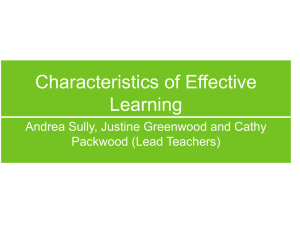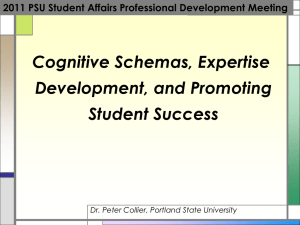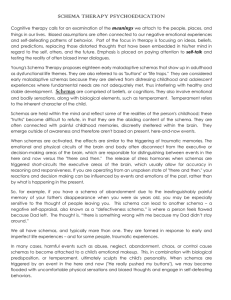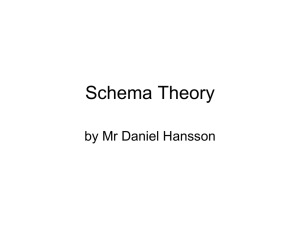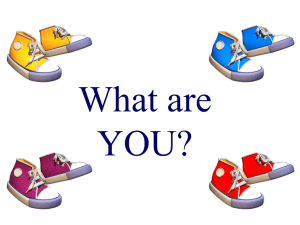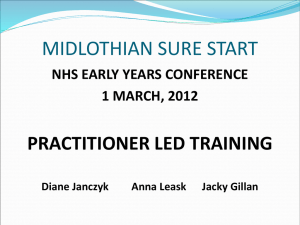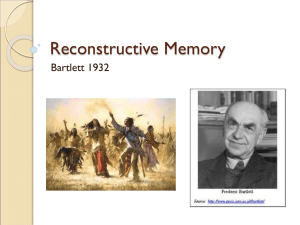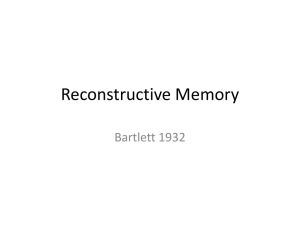About schemas (doc format, 611Kb)
advertisement
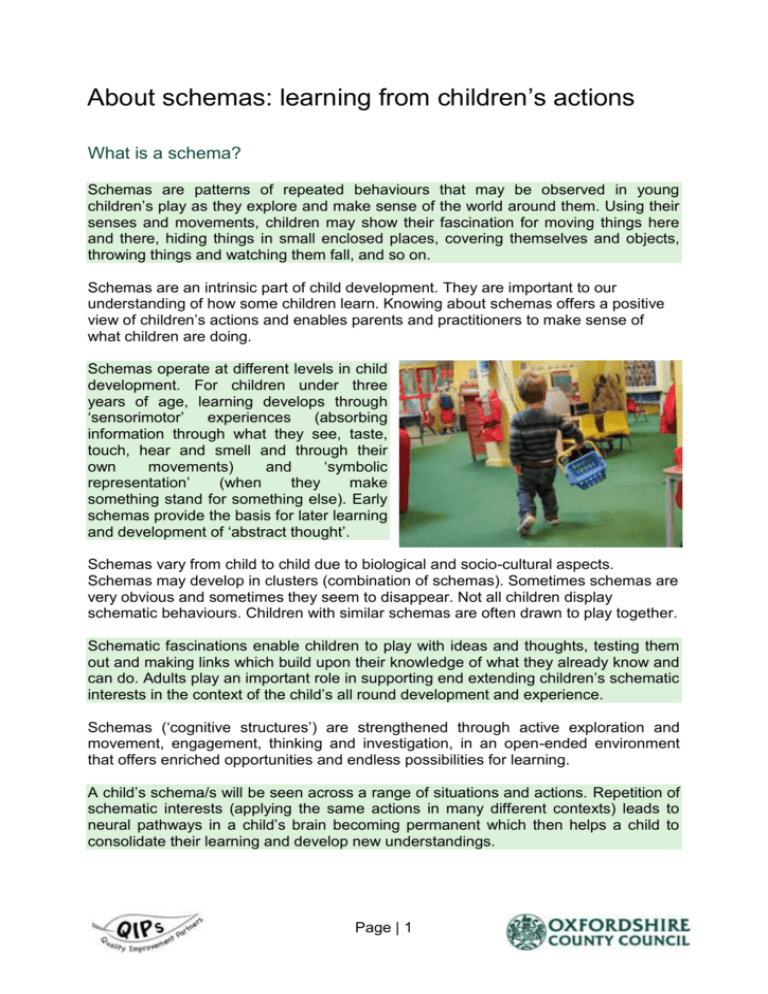
About schemas: learning from children’s actions What is a schema? Schemas are patterns of repeated behaviours that may be observed in young children’s play as they explore and make sense of the world around them. Using their senses and movements, children may show their fascination for moving things here and there, hiding things in small enclosed places, covering themselves and objects, throwing things and watching them fall, and so on. Schemas are an intrinsic part of child development. They are important to our understanding of how some children learn. Knowing about schemas offers a positive view of children’s actions and enables parents and practitioners to make sense of what children are doing. Schemas operate at different levels in child development. For children under three years of age, learning develops through ‘sensorimotor’ experiences (absorbing information through what they see, taste, touch, hear and smell and through their own movements) and ‘symbolic representation’ (when they make something stand for something else). Early schemas provide the basis for later learning and development of ‘abstract thought’. Schemas vary from child to child due to biological and socio-cultural aspects. Schemas may develop in clusters (combination of schemas). Sometimes schemas are very obvious and sometimes they seem to disappear. Not all children display schematic behaviours. Children with similar schemas are often drawn to play together. Schematic fascinations enable children to play with ideas and thoughts, testing them out and making links which build upon their knowledge of what they already know and can do. Adults play an important role in supporting end extending children’s schematic interests in the context of the child’s all round development and experience. Schemas (‘cognitive structures’) are strengthened through active exploration and movement, engagement, thinking and investigation, in an open-ended environment that offers enriched opportunities and endless possibilities for learning. A child’s schema/s will be seen across a range of situations and actions. Repetition of schematic interests (applying the same actions in many different contexts) leads to neural pathways in a child’s brain becoming permanent which then helps a child to consolidate their learning and develop new understandings. Page | 1 Active learning through schemas with people, objects and ideas engages and involves children for sustained periods of time and helps them to learn in deep and thorough ways, thus enabling them to make good progress in their own learning. Linking schematic behaviours with well-loved stories, songs and rhymes, providing a flexible environment with opportunity to combine materials and extending provision outdoors helps children make connections in meaningful ways. The active and creative ways in which children learn and how they think about the world and make sense of their experiences of it enable us to go deeper, broader and forward with planning for the child’s development and learning. A practitioner’s planning will be more appropriate if occasional actions and fleeting interests are not identified as schemas. Daily, ongoing observations of children’s interests will significantly inform both planning and provision Identifying schemas and supporting learning Knowledge of schemas and understanding schematic behaviour in young children can help practitioners to: understand why children are doing certain things describe children’s actions and behaviours in new ways support parents’ understanding of their children’s learning inform planning for children’s individual interests, preoccupations and abilities be more effective in supporting children’s learning through thought extension and modelling of language, and the provision of enjoyable experiences provide real and first-hand experiences for exploration and experimentation enable repetition of opportunities Why not create a schema display for parents to prompt conversations about their children’s fascinations at home and in the setting? Page | 2 Schemas and under threes – Identifying common schemas and supporting schematic interests Schema Transporting Enveloping Trajectory (straight lines) Rotating (circles) What it means Examples of what a child may do What adults could do to extend Moving resources and self from place to place Carries items to a special person; moves objects in wheeled toys; puts things in bags and moves them from place to place; carries sand in bucket and takes playdough to the home corner; pushes friends around in a toy pushchair Provide wheelbarrows to move sand; give items that can be moved and provide bags, baskets, containers, trolleys and pushchairs; take on picnics, go on trips or watch trains and buses transporting people, play travelling games with lined up chairs or boxes for going on a bus/train; sing ‘Down at the station’ or ‘The wheels on the bus’; read ‘Whatever next’, etc. Hides under blankets, bath robes, scarves, material, in boxes or dens; loves wearing hats; may cover their face with flannel when washing; wraps things up, paints over pictures; sits in a sand tray and covers their legs with sand; folds a picture and then wraps in more layers of paper Model and provide resources for wrapping presents, practicing wrapping things around with ribbons or tape or putting letters into envelopes; provide playdough to wrap around/hide toys in; sing ‘Wind the bobbin up’ demonstrating actions with materials; have dressing up clothes, hats and scarves available for putting layers on; have shredded paper; play pass the parcel, ‘hide and seek’ and ‘peek-a-boo games’; make houses with roofs; model words such as ‘hiding’ or ‘disappear’, etc. Learning about movement of things and self in vertical, horizontal and diagonal lines, still and in motion Drops things form high chair or cot; throws things; may gaze at your face; lines things up; climbs up and over; jumps off furniture; runs up and down; draws or paints lines; follows lines painted on the floor/ground; plays with running water in the bathroom; likes to go through tunnels; makes trails with glue; pushes cars or pushchairs in a straight line; knocks over structures built by other children; likes to wear clothes with stripes Provide balls of different sizes; build slopes and ramps to roll things down; provide target throwing opportunities; provide a variety of building bricks and other resources to build towers and knock them down; have available percussion instruments; provide opportunities to experience space and movement in/out, to move under, climb up, move across; play with ribbons waving them up/down or side to side; at mealtimes provide suitable things to drop down rather than food; begin to introduce language of ‘over/under’, fast/slow, high/low; provide leaves or feathers to watch them falling down, etc. Exploring things that turn, including self Interested in wheels and cogs; likes twirling and twisting themselves, enjoys spinning round or being swung around; runs in circles; rolls down a Provide hoops and tyres to roll around, play parachute and circle games; provide toys which have moving parts to turn around, provide spinning tops, clocks, Covering themselves or other items Page | 3 hill, turns taps on and off, draws circles, likes to watch fans, washing machines and whisks in movement, reaches for round objects near them; likes to watch rolling balls kaleidoscope and water wheels; roll with rolling pins; make windmills; use stickers for decoration; talk about shapes and spy the around; compare circles; sing ‘Round and round the garden’ with finger actions or ‘Wind the bobbin up’ with bobbin, etc. Joining and separating Gives and collects objects from adult; enjoys construction toys which involve joining things together; takes things apart, joins the table and chair by sticking tape across; ties a string to crates or bikes Provide a variety of construction toys, trains and train track; provide pegs, string and tape to connect things together; provide ribbons to weave in and out of resources; provide magnetic toys, pipes, tubes and guttering, locks and chains for exploration and to practice connecting, etc. Surrounding self, objects or space with a border Plays with farm animals and makes fences for them; builds enclosures with bricks and puts objects inside; puts cars in a garage, may draw a line around their picture; likes to sit inside a space such as basket or tyre; may surround themselves with cushions Provide peg boards to make borders or duplo boards for building houses: provide resources to make borders on paper and 3-d; barrels and tunnels are good for hiding in as are den building materials and pieces of fabric, etc. Containing Putting self or things inside other objects Posts things behind radiators or in bins; likes to put objects inside boxes, bags and pots, likes to climb into boxes and hide in the cupboards; plays in tents; loves to fill up buckets with sand; may put their thumb in and out of their mouth Play hide and seek games; provide opportunities for burying and digging objects out; provide shape sorting toys, provide a variety of containers, such as boxes and tins to put collections of items in, etc. Positioning Placing objects or themselves in particular places Lies on the floor or under a table; may put things on their head; walks around the edge of a sandpit; prefers to have food items separated on a plate; enjoys lining up cars and threading beads/buttons; likes to stand at the front or back of a line Provide tyres, crates and boxes in different places and at different heights for children to position themselves or objects in; provide sweet and biscuit tins or wooden boxes and pegs for positioning around, make caterpillars or trains, etc. Dabbing Random or specific marks Interested in making marks such as spots or eyes Look for patterns that contain dots and dabs; provide opportunities to spot with paint or dab pens; look at ladybirds, flower heads, eyes, etc. Exploring changes Likes to see, manipulate and explore changes with dry/wet materials; may add juice to their mashed potato; likes to mix sand and water Provide a variety of malleable materials; let children mix paints, add colour to cornflour or water to clay; engage children in cooking activities; explain changes, etc. Connecting Enclosing Transforming Page | 4 References/further reading Arnold, C and the Pen Green Team (2010), Understanding Schemas and Emotion in Early Childhood, London: Sage Publishers. Atherton, F and Nutbrown, C (2012), Schemas: from birth to three, London: Sage Publishers. Athey, C (2007) Extending Thought in Young Children: A Parent-Teacher Partnership, London: Sage Publishers. Early Education (2012), Understanding schemas in young children: how practitioners use schematic behaviour to support learning and development, No. 68, Autumn 2012. Louis, S (2011), Schemas outdoors, Early Education leaflet, ISBN: 978-0-90418750-2. Nutbrown, C (2011), Threads of Thinking: Schemas and young children’s learning, London: Sage Publishers. The Pen Green Centre ‘A schema booklet for parents and carers’, available at: www.pengreen.org Page | 5
